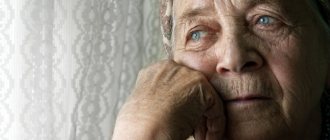- home
- Helpful information
- Rehabilitation issues
- Social and psychological maladaptation of older people
With maladaptation, a person gradually loses the ability to adapt to external conditions, interact with other people, the social environment, etc. For older people, this problem is especially serious. After retirement, as health deteriorates and mental problems arise, socio-psychological disadaptation occurs, and difficulties arise in interacting with the outside world.
Psychological disorders
Their set is determined by the causes of maladaptation, personality characteristics, and mental state. The following problems may occur.
Aggression. It becomes more difficult for an older person to communicate and interact with others. Because of this, negative thinking, hostility, and a negative attitude are formed. With maladjustment, the skill of finding a compromise, discussing, and developing agreements is lost. Instead, the person tries to achieve what he wants through direct aggressive behavior, pressure, or manipulation.
Closedness. In old age, there are fewer reasons to communicate with others, and almost all interests and social connections are gradually lost. Communication skills are lost, a person uses them less and less. He withdraws into himself, avoids any contact, becomes silent, prefers loneliness, strives to “protect” his mood, intentions, and attitudes from other people.
Egocentrism. Against the background of isolation and lack of communication, a person plunges deeper and deeper into his own inner experiences.
He is completely focused on himself, external events or conditions lose significance. Only his interests, desires, and motives become important. The ability to empathize and understand others sharply decreases. Egocentrism may be accompanied by deep feelings about one’s “uselessness” and isolation from society, but they do not lead to real actions. You have questions?
We will call you back within 30 seconds
or call the number
Clicking the "Submit"
, you automatically consent to the processing of your personal data and accept the terms of the User Agreement.
If such violations are not compensated for, behavior and emotional state will gradually worsen. Possible appearance:
- touchiness. Concentration on oneself, one's desires and needs provokes a severe reaction if the elderly person is left unattended. He may demand constant participation and be offended and worried when he does not receive it;
- suspiciousness, anxiety. The less interaction with the outside world, the more dangerous it begins to seem. Any events carry a threat, changes are always perceived negatively, only bad things can be expected from every situation;
- apathy, depression. Develops against the backdrop of refusal to communicate. The level of activity gradually decreases, interests are lost, and there is no desire to do ordinary things. Without correction, a person stops showing any initiative;
- illusions. They are usually negative in nature, and their appearance often provokes suspiciousness. Against this background, suspicion increases, and the attitude towards others and relatives can become hostile. This can create unhealthy illusions: an elderly person believes that they want to rob him, poison him, harm him, etc. Together with isolation, such beliefs can turn into a delusional state.
Social disorders
Often associated with communication problems, decreased activity, changes in social status, and lifestyle.
Problems with meeting social needs. These are difficulties in communication and interaction with other people. They arise at all levels: from maintaining relationships within the family to one-time contacts with salespeople in stores, service workers, etc.
Difficulty maintaining social roles. These are problems with recognizing oneself as a pensioner, with changes in status in society and within the family, and the inability to adapt to them.
Frequent external or internal conflicts. An elderly person cannot do without them or maintain a calm state for a long time. This is associated with psychological disorders: suspiciousness, suspicion, anxiety, irritability.
Inability to perform social functions. They stay even after retirement. This could be helping friends, acquaintances, participating in raising grandchildren, running a household together with other family members, etc. Due to maladjustment, an elderly person may either refuse to perform such functions or lose the ability to do so.
Article:
The problems of preschool childhood often attract attention only when they develop into school difficulties and only then do parents begin to understand that time has been lost, that it is in preschool childhood that the child’s basic knowledge, skills and values are formed.
Social adaptation is one of the components of psychological readiness for school. Every year more and more children who cannot establish contact with their peers, with the teacher, solve problems only with the help of their fists, become outcasts in the class. This means that the child’s psyche suffers and his academic performance decreases.
Social adaptation is the process of an individual’s active adaptation to the conditions of the social environment. Society is society, which means social adaptation is the ability to live in society, have knowledge about it, and comply with the norms of communication and behavior in society. Pestallotsi I.G. believed that the happiness of each person depends on the degree of his adaptability to live in the social conditions in which he was born. So, if adaptation is an individual’s adaptation to the conditions of the social environment, then disadaptation is his inability for some external or internal reasons to live in society. Internal reasons: developmental disorders - disabled children, mentally retarded children (they have incomplete ideas about the social environment, blurred life prospects, passive attitude towards social life) External reasons: lack of educational resources of parents, asocial families, raising a child in an incomplete family, outside the family (orphanages). Raising a child outside the family is a very serious problem in our society; the statistics are that 70-75% of children left without parental care have neuropsychiatric pathologies, have persistent emotional disturbances, do not adapt well to social life and often lead an asocial lifestyle in the future. The UN Convention on the Rights of the Child (1989) “recognizes the importance of the family as the primary social group and natural setting for the growth and well-being of children.” At the same time, the essence of the modern position is that this is not so much a right over the child (submission to parents), but rather a responsibility towards him. Recognizing the value of the family, it is important to note that many parents do not show a parental attitude that takes into account the characteristics of the child’s emotional and personal development. Many mistakes in parental attitudes toward children lie in their inadequate understanding of their parental role. They often transfer onto their children those relationships that reproduce the nature of their parents’ relationships towards them in early childhood or what they did not receive from their parents in their childhood. A serious and essentially family-oriented psychocorrectional task faces a psychologist not in diagnosing parents and assessing their inadequacy, but in helping them realize the need to become “good parents” who understand the problems of children and strive for the correct development and socialization of children. This means: • Expand the child’s knowledge about society (visiting exhibitions, museums, theaters, etc.); • Expand the child’s horizons: watching educational TV shows together, reading stories, fairy tales..., joint activities with the child); • Maintain a culture of communication and behavior in the family (children are a mirror of their parents); • Actively listen and understand the child’s experiences and needs; • Strive to resolve conflicts that arise with the child without threats or punishment, trust his understanding and share his feelings that arose due to the conflict, explain them, react to emotions through games and drawings. • Support the child's success; • Eliminate inconsistent demands and empty threats, expressions of dissatisfaction with the child; • Know the age norms and developmental characteristics of preschool children and exclude unrealistic parental expectations for the child. These simple rules turn out to be the most effective means of primary prevention of social maladjustment in children. You don’t have to be a child psychotherapist to convey them. The overall result of such work with parents “in a problem family” is the understanding that “good parental attitude” is the result of family trust, recognition, and not fear and pressure, and that violence against children is evil. What is done in kindergarten to prevent social maladaptation. The administration: • Holds open days for parents. • Garden-wide parent meetings are held. • In the kindergarten there is a club “Parental home - the beginning of the beginning”. • The administration enters into cooperation agreements with museums, theaters, exhibitions, and children visit these public institutions throughout the year. • A plan for cooperation with school No. 25 has been drawn up.
Educators: • Work is carried out to familiarize them with the environment, life safety, ecology and valeology, familiarization with the history and culture of peoples. • A developmental environment is created. • Artistic and creative activities are developed (theatrical, role-playing games, family drawings, performances at holidays...) • Children are introduced to the rights of the child. • The child is socialized through fiction. • A culture of communication and behavior in the child is instilled. • Joint celebrations with parents, exhibitions of works, tea parties are held... • Teachers “include” parents in the life of the group.
Teacher-psychologist: • Examines children and identifies children at “risk” and families at “social risk” (dysfunctional families). Throughout the year, individual and subgroup work is carried out with them. • Sociometry of groups is carried out, children with low status are identified, and measures are taken to increase the status of these children in the peer group and increase their self-esteem. • Group activities are held once a week for children of senior preschool age to develop communication skills and socialization. • As the groups are completed, parent-child meetings are held with elements of training. • Scheduled and upon request consultations with teachers and parents are conducted. • Speeches at pedagogical councils and parent-teacher meetings.
Dear parents! Remember that for a child - preschooler, parents are the standard in everything. The child copies everything, both good and bad, not without reason, folk wisdom says - children are the mirror of their parents! Therefore, the level of social adaptation of the child, and therefore his future fate, will depend on what kind of parents, what kind of relationships in the family, what model of upbringing the parents chose, how competent they are in matters of upbringing. Love your child in any way. And remember that not enough has been done for the child if everything has not been done! Good luck to you and your child!
Risk factors for social and psychological maladjustment in older people
Loneliness. It is considered the main provoking moment. The person becomes isolated and communicates less. Gradually, communication skills are lost, and existing emotional problems become more acute. This triggers maladaptation, which quickly becomes uncontrollable. It is impossible to cope with it on your own. Negative changes occur especially quickly if there are no relatives or loved ones nearby.
Social environment. In Russia, it is considered one of the most “unfriendly” towards older people. Social services are minimal and not available to all pensioners. Volunteer activities are carried out in limited quantities. The elderly have almost no “platforms”, opportunities for communication, or the formation of new interests. Starting from a certain age, a person finds himself in isolation: it becomes increasingly difficult for him to maintain a normal amount of communication and social activity, even if he wants to do it.
Personality characteristics. With age, unpleasant character traits can “sharpen” and appear more clearly. This increases maladaptation - negative thinking becomes dominant, and the level of criticism of one’s own actions decreases.
Factors of social maladjustment
Social maladjustment is a fairly diverse phenomenon, which, in addition to symptoms, is also based on a number of factors that influence its character and complicate the individual’s social adaptation to the conditions surrounding him. Factors of social maladjustment include the following:
Finished works on a similar topic
Course work Factors of social maladjustment 480 ₽ Abstract Factors of social maladjustment 250 ₽ Test work Factors of social maladjustment 240 ₽
Receive completed work or specialist advice on your educational project Find out the cost
- Cultural and social deprivation, which can range from mild to severe. In this case, it is expressed in the fact that the individual is forcibly or at his own request deprived of various benefits and needs that play an important role in his life. Without these benefits, a person cannot exist normally, engage in a certain type of activity, or establish contacts with people for communication and exchange of information.
- Psychological and pedagogical neglect, which most often comes from the early childhood of an individual. Responsibility for neglect lies with the person’s parents, as well as with teachers who were inattentive and dismissive towards the individual.
- Overstimulation by new social values and norms. When entering a new environment, it is important for a person to gradually adapt and timely accept new norms. But if he enters the environment abruptly and is offered a large number of values, this leads to rejection and rejection. In addition, the person begins to experience discomfort and feels inferior because he thinks that he does not have sufficient skills to perceive new norms and conditions.
Also, factors of social maladaptation include insufficient preparedness for self-regulation processes (lack of knowledge and skills to take advantage of new norms and values); loss of established forms of mentoring (loss of family, guardian, teacher); loss of the usual team (due to illness, change of activity, moving to another country); low degree of psychological readiness to master the profession (insufficient level of communication, responsibility, desire to work on one’s mistakes and gain new knowledge); breaking dynamic stereotypes, character accentuations, psychopathic personality formation in conflict conditions.
Prevention of maladjustment in older people
It is important for an elderly person to remain active, to feel needed and useful. The key role in this is played by the close environment, the family. It is important to maintain a wide (but feasible) range of responsibilities for as long as possible, emphasize the importance of an elderly relative, communicate with him as much as possible, and involve him in participation in family life. Contact with peers and representatives of other generations, a high level of social activity, participation in public affairs, volunteering, etc., protect well from maladjustment.
Another direction of prevention is medical control. Med recommends regular examination by a psychotherapist or psychiatrist. With age, cognitive impairment, pathological conditions and diseases appear that require medical supervision. It is important to diagnose them in time. This will help delay the onset of maladjustment or avoid it altogether.
Sign up for a consultation
- Choosing a rehabilitation center
- Stages of rehabilitation
- Massage as a means of rehabilitation
- Drawing up rehabilitation programs
- Treatment of senile dementia
- Hallucinations in the elderly
- Rehabilitation after strokes
- Rehabilitation after traumatic brain injuries
- Therapeutic exercise in rehabilitation after injuries and diseases
- Laboratory diagnostics during the rehabilitation period
- Social and psychological maladaptation of older people
- Physical activity in rehabilitation of the elderly
- Diet therapy as part of rehabilitation of the elderly
- Rehabilitation of elderly people with alcohol dependence
- Clinical syndromes characteristic of older people and methods of correction
- Medical rehabilitation for dementia










